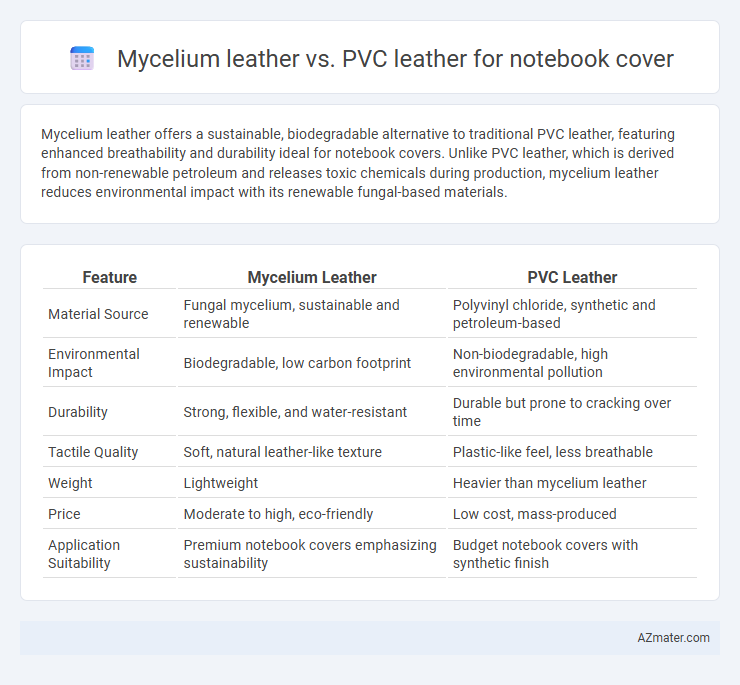Mycelium leather offers a sustainable, biodegradable alternative to traditional PVC leather, featuring enhanced breathability and durability ideal for notebook covers. Unlike PVC leather, which is derived from non-renewable petroleum and releases toxic chemicals during production, mycelium leather reduces environmental impact with its renewable fungal-based materials.
Table of Comparison
| Feature | Mycelium Leather | PVC Leather |
|---|---|---|
| Material Source | Fungal mycelium, sustainable and renewable | Polyvinyl chloride, synthetic and petroleum-based |
| Environmental Impact | Biodegradable, low carbon footprint | Non-biodegradable, high environmental pollution |
| Durability | Strong, flexible, and water-resistant | Durable but prone to cracking over time |
| Tactile Quality | Soft, natural leather-like texture | Plastic-like feel, less breathable |
| Weight | Lightweight | Heavier than mycelium leather |
| Price | Moderate to high, eco-friendly | Low cost, mass-produced |
| Application Suitability | Premium notebook covers emphasizing sustainability | Budget notebook covers with synthetic finish |
Introduction to Mycelium and PVC Leather
Mycelium leather, derived from mushroom root networks, offers a sustainable and biodegradable alternative to traditional PVC leather, which is a synthetic material made from polyvinyl chloride. Mycelium leather boasts low environmental impact due to its natural origin and compostability, while PVC leather is known for durability but involves petrochemical processes and potential toxicity. Choosing mycelium leather for notebook covers supports eco-friendly design without sacrificing texture and aesthetic appeal present in PVC leather options.
Material Composition and Production Processes
Mycelium leather, derived from fungal root structures, offers a sustainable and biodegradable alternative to PVC leather, which is made from polyvinyl chloride, a synthetic plastic polymer. Mycelium leather production involves cultivating fungi in controlled environments, minimizing chemical use and environmental impact, whereas PVC leather manufacturing relies on petroleum-based chemicals and releases harmful toxins during processing and disposal. The natural cellulose structure of mycelium provides breathability and flexibility, contrasting with the non-breathable, rigid properties of PVC leather that often require plasticizers to achieve softness.
Environmental Impact and Sustainability
Mycelium leather, derived from fungal mycelium, offers a biodegradable and renewable alternative to PVC leather, which is a synthetic plastic made from non-renewable petroleum resources. The production of mycelium leather generally results in lower carbon emissions and reduced toxic waste compared to PVC leather manufacturing, which often involves harmful chemicals and generates significant environmental pollution. Choosing mycelium leather for notebook covers supports sustainability by minimizing landfill waste and promoting eco-friendly material cycles, unlike PVC leather that poses long-term environmental hazards due to its non-biodegradable nature.
Durability and Longevity
Mycelium leather offers superior durability compared to PVC leather due to its natural fibrous structure, making it resistant to tearing and wear over time. Unlike PVC leather, which tends to crack and degrade with prolonged use and exposure to heat, mycelium leather maintains its flexibility and strength for extended periods. Notebook covers made from mycelium leather provide enhanced longevity, ensuring better protection and a sustained aesthetic appeal throughout regular use.
Texture, Appearance, and Design Flexibility
Mycelium leather offers a naturally textured surface with a soft, supple feel that mimics genuine leather, providing a unique and eco-friendly aesthetic for notebook covers. PVC leather features a smooth, consistent texture with a glossy finish, often appearing more synthetic and less breathable than mycelium alternatives. Design flexibility in mycelium leather allows for organic patterns and customization through natural growth processes, while PVC leather affords uniformity and precise color control, making each material suitable for distinct stylistic preferences.
Weight and Handling Experience
Mycelium leather offers a lightweight alternative to PVC leather, significantly reducing the overall weight of a notebook cover and enhancing portability. The natural texture of mycelium results in a breathable, flexible surface that improves handling comfort and grip compared to the rigid, synthetic feel of PVC leather. Users often prefer mycelium for its eco-friendly origin and tactile softness, which contribute to a superior ergonomic experience.
Cost and Market Availability
Mycelium leather offers an eco-friendly alternative to PVC leather, often priced higher due to its sustainable production process and limited mass-market availability. PVC leather remains more cost-effective and widely accessible, dominating the notebook cover market with its affordability and established manufacturing infrastructure. Consumers prioritizing environmental impact tend to choose mycelium leather despite its premium cost and narrower distribution channels.
Biodegradability and End-of-Life Disposal
Mycelium leather offers superior biodegradability compared to PVC leather, breaking down naturally within months in composting conditions due to its organic, fungal origin. PVC leather, made from polyvinyl chloride, resists decomposition and releases toxic chemicals when incinerated or landfilled, posing significant environmental hazards. Choosing mycelium leather for notebook covers supports sustainable end-of-life disposal, reducing plastic pollution and facilitating circular economy principles.
Health and Safety Considerations
Mycelium leather is a sustainable and non-toxic alternative to PVC leather, as it is free from harmful chemicals like phthalates and heavy metals that are commonly found in PVC. It is biodegradable and poses fewer health risks related to skin irritation or chemical exposure, making it safer for prolonged contact with notebook covers. PVC leather often releases volatile organic compounds (VOCs) during manufacturing and use, which can impact indoor air quality and pose respiratory risks.
Choosing the Best Leather for Your Notebook Cover
Mycelium leather offers a sustainable, biodegradable alternative to traditional PVC leather, making it an eco-friendly choice for notebook covers. Its natural texture provides durability and breathability while avoiding toxic chemicals found in PVC, which is derived from non-renewable fossil fuels and prone to cracking over time. Choosing mycelium leather supports environmentally conscious manufacturing without compromising on style or functionality for your notebook cover.

Infographic: Mycelium leather vs PVC leather for Notebook cover
 azmater.com
azmater.com